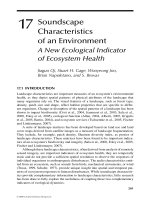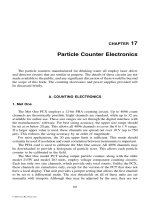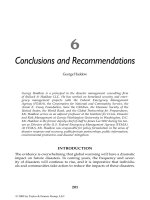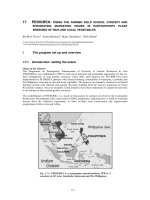Slide Financial Management - Chapter 17 pdf
Bạn đang xem bản rút gọn của tài liệu. Xem và tải ngay bản đầy đủ của tài liệu tại đây (137.05 KB, 25 trang )
17-1
CHAPTER 17
Financial Planning and Forecasting
Forecasting sales
Projecting the assets and internally
generated funds
Projecting outside funds needed
Deciding how to raise funds
17-2
Balance sheet (2002),
in millions of dollars
Cash & sec. $ 20 Accts. pay. &
accruals $ 100
Accounts rec. 240 Notes payable 100
Inventories 240 Total CL $ 200
Total CA $ 500 L-T debt 100
Common stock 500
Net fixed Retained
assets 500
earnings 200
Total assets $1,000 Total claims $1,000
17-3
Income statement (2002),
in millions of dollars
Sales $2,000.00
Less: Var. costs (60%) 1,200.00
Fixed costs 700.00
EBIT $ 100.00
Interest 16.00
EBT $ 84.00
Taxes (40%) 33.60
Net income $ 50.40
Dividends (30%) $15.12
Add’n to RE $35.28
17-4
Key ratios
NWC Industry Condition
BEP 10.00% 20.00% Poor
Profit margin 2.52% 4.00% ”
ROE 7.20% 15.60% ”
DSO 43.80 days 32.00 days ”
Inv. turnover 8.33x 11.00x ”
F. A. turnover 4.00x 5.00x ”
T. A. turnover 2.00x 2.50x ”
Debt/assets 30.00% 36.00% Good
TIE 6.25x 9.40x Poor
Current ratio 2.50x 3.00x ”
Payout ratio 30.00% 30.00% O. K.
17-5
Key assumptions
Operating at full capacity in 2002.
Each type of asset grows proportionally with
sales.
Payables and accruals grow proportionally
with sales.
2002 profit margin (2.52%) and payout
(30%) will be maintained.
Sales are expected to increase by $500
million. (%ΔS = 25%)
17-6
Determining additional funds
needed, using the AFN equation
AFN
= (A*/S
0
)ΔS –
(L*/S
0
) ΔS –
M(S
1
)(RR)
= ($1,000/$2,000)($500)
–
($100/$2,000)($500)
–
0.0252($2,500)(0.7)
= $180.9 million.
17-7
How shall AFN be raised?
The payout ratio will remain at 30 percent
(d = 30%; RR = 70%).
No new common stock will be issued.
Any external funds needed will be raised as
debt, 50% notes payable and 50% L-T
debt.
17-8
Forecasted Income Statement (2003)
Sales $2,000 1.25 $2,500
Less: VC 1,200 0.60 1,500
FC 700
0.35 875
EBIT $ 100 $ 125
Interest 16
16
EBT $ 84 $ 109
Taxes (40%) 34
44
Net income $ 50 $ 65
Div. (30%) $15 $19
Add’n to RE $35 $46
Forecast
Basis
2003
Forecast
2002
17-9
2003
1
st
Pass
Forecasted Balance Sheet (2003)
Assets
2002
Forecast
Basis
Cash $ 20 0.01 $ 25
Accts. rec. 240 0.12 300
Inventories 240
0.12 300
Total CA $ 500 $ 625
Net FA 500
0.25 625
Total assets $1,000 $1,250
17-10
2003
1
st
Pass
2002
Forecast
Basis
Forecasted Balance Sheet (2003)
Liabilities and Equity
AP/accruals $ 100 0.05 $ 125
Notes payable 100
100
Total CL $ 200 $ 225
L-T debt 100 100
Common stk. 500 500
Ret.earnings 200
+46* 246
Total claims $1,000 $1,071
* From income statement.
17-11
What is the additional
financing needed (AFN)?
Required increase in assets = $ 250
Spontaneous increase in liab. = $ 25
Increase in retained earnings = $ 46
Total AFN = $ 179
NWC must have the assets to generate
forecasted sales. The balance sheet must
balance, so we must raise $179 million
externally.
17-12
How will the AFN be financed?
Additional N/P
0.5 ($179) = $89.50
Additional L-T debt
0.5 ($179) = $89.50
But this financing will add to interest
expense, which will lower NI and retained
earnings. We will generally ignore financing
feedbacks.
17-13
2003
2
nd
Pass
2003
1
st
Pass
AFN
Forecasted Balance Sheet (2003)
Assets –
2
nd
pass
Cash $ 25 - $ 25
Accts. rec. 300 - 300
Inventories 300
-300
Total CA $ 625 $ 625
Net FA 625
-625
Total assets $1,250 $1,250
17-14
2003
2
nd
Pass
2003
1
st
Pass
AFN
Forecasted Balance Sheet (2003)
Liabilities and Equity –
2
nd
pass
AP/accruals $ 125 - $ 125
Notes payable 100
+89.5 190
Total CL $ 225 $ 315
L-T debt 100 +89.5 189
Common stk. 500 - 500
Ret.earnings 246
-246
Total claims $1,071 $1,250
* From income statement.
17-15
Why do the AFN equation and financial
statement method have different results?
Equation method assumes a constant
profit margin, a constant dividend payout,
and a constant capital structure.
Financial statement method is more
flexible. More important, it allows
different items to grow at different rates.
17-16
Forecasted ratios (2003)
2002 2003(E) Industry
BEP 10.00% 10.00% 20.00% Poor
Profit margin 2.52% 2.62% 4.00% ”
ROE 7.20% 8.77% 15.60% ”
DSO (days) 43.80 43.80 32.00 ”
Inv. turnover 8.33x 8.33x 11.00x ”
F. A. turnover 4.00x 4.00x 5.00x ”
T. A. turnover 2.00x 2.00x 2.50x ”
D/A ratio 30.00% 40.34% 36.00% ”
TIE 6.25x 7.81x 9.40x ”
Current ratio 2.50x 1.99x 3.00x ”
Payout ratio 30.00% 30.00% 30.00% O. K.
17-17
What was the net investment in
operating capital?
OC
2003
= NOWC + Net FA
= $625 -
$125 + $625
= $1,125
OC
2002
= $900
Net investment in OC = $1,125 - $900
= $225
17-18
How much free cash flow is expected
to be generated in 2003?
FCF
= NOPAT
–
Net inv. in OC
= EBIT (1 –
T) –
Net inv. in OC
= $125 (0.6) –
$225
= $75 –
$225
= -$150.
17-19
Suppose fixed assets had only been
operating at 75% of capacity in 2002
Additional sales could be supported with the
existing level of assets.
The maximum amount of sales that can be
supported by the current level of assets is:
Capacity sales = Actual sales / % of capacity
= $2,000 / 0.75 = $2,667
Since this is less than 2003 forecasted sales,
no additional assets are needed.
17-20
How would the excess capacity
situation affect the 2003 AFN?
The projected increase in fixed assets
was $125, the AFN would decrease by
$125.
Since no new fixed assets will be
needed, AFN will fall by $125, to
AFN = $179 – $125 = $54.
17-21
If sales increased to $3,000 instead, what
would be the fixed asset requirement?
Target ratio = FA / Capacity sales
= $500 / $2,667 = 18.75%
Have enough FA for sales up to $2,667,
but need FA for another $333 of sales
ΔFA = 0.1875 ($333) = $62.4
17-22
How would excess capacity
affect the forecasted ratios?
Sales wouldn’t change but assets
would be lower, so turnovers would
be better.
Less new debt, hence lower interest,
so higher profits, EPS, ROE (when
financing feedbacks were considered).
Debt ratio, TIE would improve.
17-23
Forecasted ratios (2003)
with projected 2003 sales of $2,500
% of 2002 Capacity
100% 75% Industry
BEP 10.00% 11.11% 20.00%
Profit margin 2.62% 2.62% 4.00%
ROE 8.77% 8.77% 15.60%
DSO (days) 43.80 43.80 32.00
Inv. turnover 8.33x 8.33x 11.00x
F. A. turnover 4.00x 5.00x 5.00x
T. A. turnover 2.00x 2.22x 2.50x
D/A ratio 40.34% 33.71% 36.00%
TIE 7.81x 7.81x 9.40x
Current ratio 1.99x 2.48x 3.00x
17-24
How is NWC managing its receivables
and inventories?
DSO is higher than the industry
average, and inventory turnover is
lower than the industry average.
Improvements here would lower
current assets, reduce capital
requirements, and further improve
profitability and other ratios.
17-25
How would the following items
affect the AFN?
Higher dividend payout ratio?
Increase AFN: Less retained earnings.
Higher profit margin?
Decrease AFN: Higher profits, more retained
earnings.
Higher capital intensity ratio?
Increase AFN: Need more assets for given sales.
Pay suppliers in 60 days, rather than 30 days?
Decrease AFN: Trade creditors supply more
capital (i.e., L*/S
0
increases).









